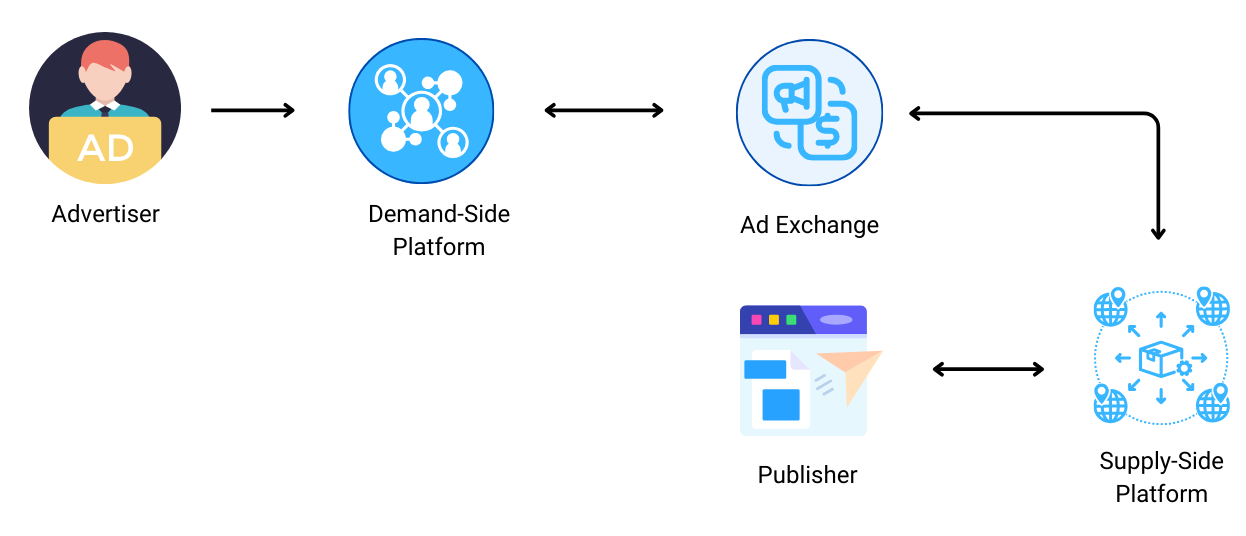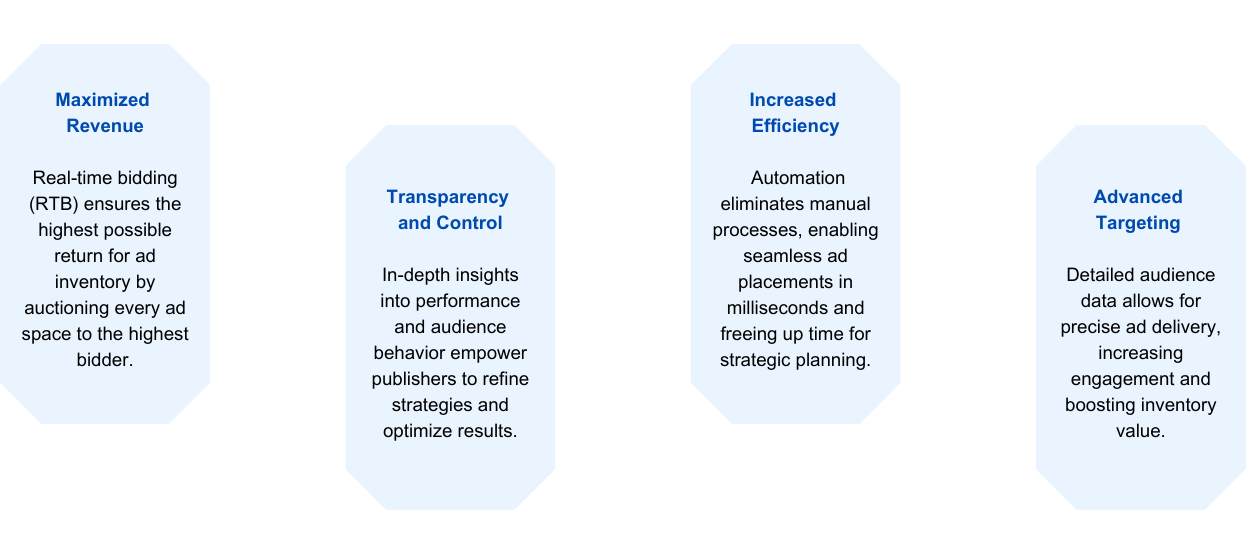Programmatic advertising is not just thriving—it’s transforming the digital advertising landscape. Projected to surpass $150 billion in spending this year, it continues to be a powerful tool for businesses looking to maximize their advertising reach and efficiency. As a publisher or advertiser, embracing programmatic advertising can unlock significant revenue potential and ensure you’re well-positioned in this competitive market.
In this comprehensive guide, we’ll explore the various aspects of programmatic advertising, from its foundational concepts to advanced strategies for scaling revenue.
What is Programmatic Advertising?
Think of programmatic advertising as a high-tech, lightning-fast auction for online ad space. When a visitor lands on your website, your ad space is instantly put up for auction. Advertisers bid in real-time to place their ads on your site, and the highest bidder’s ad gets displayed. This entire process, driven by sophisticated algorithms, happens in milliseconds.
For publishers, this means you get the best possible price for your ad space every single time. It’s like having an automated, 24/7 salesperson ensuring you’re maximizing revenue from each visitor.
How Does Programmatic Advertising Work?

The programmatic process involves a series of automated transactions between publishers and advertisers. Here’s a simplified breakdown:
- User Engagement: A user visits a publisher’s website or interacts with video content.
- Auction Initiation: The available ad space is offered for auction through a Supply-Side Platform (SSP).
- Real-Time Bidding (RTB): Advertisers use Demand-Side Platforms (DSPs) to bid on this ad space in real-time.
- Winning Bid Selection: The highest bid secures the ad placement.
- Ad Display: The winning ad is shown to the user—all within a fraction of a second.
Technologies like header bidding further enhance this process by allowing multiple bids to be considered simultaneously, ensuring publishers receive the highest possible payout.
A Brief History of Programmatic Advertising

In the early days of the internet, buying ad space was a manual process involving direct relationships between advertisers (buyers) and publishers (sellers). As the internet grew rapidly, ad inventory outpaced advertiser demand, leading to a surplus of unsold ad space.
This led to the creation of Ad Networks, which categorized and sold unsold inventory. Over time, more sophisticated platforms emerged:
Supply-Side Platforms (SSPs): Help publishers manage and sell their ad inventory.
Demand-Side Platforms (DSPs): Allow advertisers to manage their media buying across multiple sites through a single platform.
The integration of these platforms and the introduction of Real-Time Bidding (RTB) created the modern programmatic ecosystem we know today.
Types of Programmatic Advertising
Programmatic advertising isn’t one-size-fits-all. There are several types, each suited to different goals:
- Programmatic Direct: A fixed-price deal where ad inventory is reserved and sold directly to advertisers.
- Preferred Deals: Unreserved inventory sold at a pre-agreed price, often involving direct communication between publishers and advertisers.
- Private Marketplaces (PMPs): Exclusive auctions where select advertisers bid on premium inventory.
- Open Auctions: Public RTB environments where any advertiser can bid on available inventory.
Each type offers unique benefits, from guaranteed placements to competitive bidding, allowing publishers and advertisers to tailor their approach.
Top Channels in Programmatic Advertising

Programmatic advertising has evolved far beyond traditional display ads, offering advertisers and publishers a wide range of channels to connect with audiences across platforms. Let’s explore the key channels driving the growth of programmatic advertising:
Display Ads
Display ads are a cornerstone of programmatic advertising, offering a straightforward way to showcase content on websites:
- Placement: These ads are typically placed in headers, footers, or sidebars, ensuring visibility without disrupting the user experience.
- Collaboration: Publishers work with display networks like Google Ads or Microsoft Ads to manage inventory and track revenue.
- Effectiveness: With programmatic technology, display ads are tailored to specific audiences, improving engagement and ROI.
Video Ads
Video ads are the fastest-growing segment in programmatic advertising, driven by the rising popularity of streaming platforms and connected TVs (CTVs). They offer unparalleled engagement through visual storytelling:
- In-Stream Ads: Appear within video content, including pre-roll (before content), mid-roll (during content), and post-roll (after content) ads, like those on YouTube.
- Out-Stream Ads: Found within articles or as pop-ups, they are not tied to a video player, expanding their reach.
- In-Display Ads: Featured in video search results or recommendation sections, catching the user’s attention even before content is viewed.
Native Ads
Programmatic native ads seamlessly integrate into content, such as in-feed units and sponsored posts, providing a non-intrusive, ad-block-resistant experience. These ads combine the precision of programmatic technology with the natural design of native formats, aligning with the look, feel, and functionality of their host platforms. By leveraging audience data, programmatic native ads are dynamically placed and personalized, ensuring relevance, engagement, and effectiveness while maintaining a user-friendly, ad-block-resistant approach.
Benefits of Programmatic Advertising
Programmatic advertising has transformed the way publishers and advertisers interact, offering numerous advantages that drive revenue and efficiency. Here’s how programmatic advertising benefits publishers:

Scaling Revenue from Programmatic
Advertising with Adhub Media

Maximizing revenue through programmatic advertising is not just about automation—it’s about using the right strategies and tools. At Adhub Media, we specialize in helping publishers unlock the full potential of their programmatic ad inventory with tailored solutions.
Here’s how our approach can help you scale your revenue effectively:
Leverage Header Bidding
Header bidding has revolutionized programmatic advertising by allowing multiple demand sources to compete for ad inventory simultaneously. This competitive environment ensures:
- Higher CPMs: Publishers receive the best price for their inventory.
- Improved Fill Rates: Maximizing the number of ads displayed.
- Adhub Media offers robust header bidding solutions to streamline the bidding process, boost revenue, and enhance efficiency across all demand sources.
Optimize Ad Formats
Diversifying ad formats is key to scaling programmatic revenue and engaging audiences effectively. At Adhub Media, we maximize engagement and revenue potential by tailoring formats to user preferences and platform needs:
- Display Ads: Static, responsive, sticky, or custom-designed.
- Video Ads: High-impact instream formats with preroll, midroll, and sticky features.
- Native Ads: Seamlessly integrated, non-intrusive formats matching platform design.
- Custom Ads: Tailored formats like anchor ads, rewarded ads, and push notifications.
Use Data Effectively
Data is at the core of programmatic success. Adhub Media’s tools provide:
- Granular Audience Insights: Understand user preferences and behaviors.
- First-Party Data Utilization: Leverage your own data to deliver personalized and relevant ads.
- Actionable Analytics: Refine targeting and pricing strategies for better results.
- This data-driven approach ensures publishers stay ahead of the competition while offering unmatched value to advertisers.
Partner with Reliable SSPs
Selecting trustworthy Supply-Side Platforms (SSPs) is essential to safeguard revenue and optimize performance. At Adhub Media, we:
- Our network prioritizes your profitability and peace of mind.
- Partner with transparent SSPs to ensure visibility into ad operations.
- Provide advanced fraud protection to mitigate risks from invalid traffic (IVT).
- Offer dedicated support for seamless campaign management and optimization.
